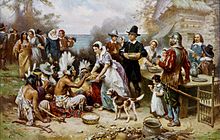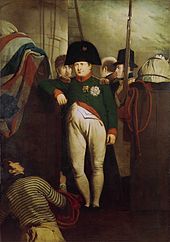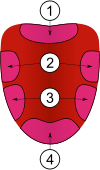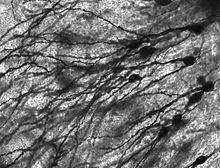
List of common misconceptions
About this schools Wikipedia selection
SOS Children made this Wikipedia selection alongside other schools resources. Visit the SOS Children website at http://www.soschildren.org/
- This incomplete list is not intended to be exhaustive.
This list pertains to current, widely held, erroneous ideas and beliefs about notable topics which have been reported by reliable sources. Each has been discussed in published literature, as has its topic area and the facts concerning it. Note that the statements which follow are corrections based on known facts; the misconceptions themselves are referred to rather than stated.
History
Ancient to early modern history
- In ancient Rome, the architectural feature called a vomitorium was the entranceway through which crowds entered and exited a stadium, not a special room used for purging food during meals. Vomiting was not a regular part of Roman dining customs.
- It is a matter of historical debate that Nero "fiddled" during the Great Fire of Rome. (Certainly he did not fiddle in the literal sense; violins had not yet been invented.) Suetonius claimed that Nero "sang a poem" while observing the fire, so delighted was he at the destruction of the city. The Roman historian Tacitus, on the other hand, claimed that upon hearing news of the fire, Nero rushed back to Rome to organize a relief effort, which he paid for from his own funds, and he also opened his palaces to provide shelter for the homeless, arranging for food supplies to be delivered in order to prevent starvation among the survivors, and finally making a new urban development plan that attempted to make it more difficult for fires to spread.
- It is true that mean life expectancy in the Middle Ages and earlier was low; however, many take this to mean that people usually died around the age of 30. In fact, the low life expectancy is an average very strongly influenced by high infant mortality, and the life expectancy of people who lived to adulthood was much higher. A 21-year-old man in medieval England, for example, could by one estimate expect to live to the age of 64.
- There is no evidence that Vikings wore horns on their helmets. In fact, the image of Vikings wearing horned helmets stems from the scenography of an 1876 production of the Der Ring des Nibelungen opera cycle by Richard Wagner.
- King Canute did not command the tide to reverse in a fit of delusional arrogance. His intent that day, if the incident even happened, was most likely to prove a point to members of his privy council that no man is all-powerful, and we all must bend to forces beyond our control, such as the tides.
- There is no evidence that iron maidens were invented in the Middle Ages or even used for torture. Instead they were pieced together in the 18th century from several artifacts found in museums in order to create spectacular objects intended for (commercial) exhibition.
- The plate armor of European soldiers did not stop soldiers from moving around or necessitate a crane to get them into a saddle. They would as a matter of course fight on foot and could mount and dismount without help. In fact soldiers equipped with plate armor were more mobile than those with chainmail armor, as chainmail was heavier and required stiff padding beneath due to its pliable nature.
- Christopher Columbus's efforts to obtain support for his voyages were not hampered by a European belief in a flat Earth. Sailors and navigators of the time knew that the Earth was roughly spherical, but (correctly) disagreed with Columbus's estimate of the distance to India, which was approximately one-sixth of the actual distance. If the Americas did not exist, and had Columbus continued to India, he would have run out of supplies before reaching it at the rate he was traveling. Without the ability to determine longitude at sea, he wouldn't have learned that his estimate was an error in time to return. Many of the educated classes believed the Earth was spherical since the works of the Greek philosophers Plato and Aristotle. Eratosthenes made an accurate estimate of the Earth's diameter in approximately 240 BCE. See also Myth of the Flat Earth.
- Columbus did not "discover America" in the sense of identifying a new continent. Although some historians argue he knew he had found a land between Europe and Asia, most of his writings show he thought he reached the eastern coast of Asia. Most of the landings Columbus made on his four voyages, including the initial October 12, 1492 landing (the anniversary of which forms the basis of Columbus Day), were in the Caribbean Islands. Columbus was not the first European to visit the Americas: at least one explorer, Leif Ericson, preceded him by reaching what today is believed to be Newfoundland, and Newfoundland was already a popular fishing site for the European powers by the time of Columbus.
- There is a legend that Marco Polo imported pasta from China which originated with the Macaroni Journal, published by an association of food industries with the goal of promoting the use of pasta in the United States. Marco Polo describes a food similar to "lagana" in his Travels, but he uses a term with which he was already familiar. Durum wheat, and thus pasta as it is known today, was introduced by Arabs from Libya, during their conquest of Sicily in the late 7th century, according to the newsletter of the National Macaroni Manufacturers Association, thus predating Marco Polo's travels to China by about six centuries.
- Contrary to the popular image of the Pilgrim Fathers, the early settlers of the Plymouth Colony did not necessarily wear all black, and their capotains (hats) were shorter and rounder than the widely depicted tall hat with a buckle on it. Instead, their fashion was based on that of the late Elizabethan era: doublets, jerkins and ruffs. Both men and women wore the same style of shoes, stockings, capes, coats and hats in a range of colors including reds, yellows, purples, and greens. Children of both sexes wore identical clothing: a chemise, an ankle-length gown, an apron and a close fitting cap tied under the chin. At the age of seven, boys were "breeched", i.e. allowed to wear adult men's clothing. According to Plimoth Plantation historian James W. Baker, the traditional image was formed in the 19th century when buckles were a kind of emblem of quaintness.
- The thanksgiving at Plymouth Colony, widely believed to be the "First Thanksgiving", was not the first day of thanksgiving on the North American continent. Preceding thanksgiving days were held at the Spanish colony of Saint Augustine, Florida in 1565, in Frobisher Bay in 1578, in French Canada beginning in 1604, in Jamestown, Virginia in 1607, and at Berkeley Hundred in 1619, in addition to numerous similarly themed indigenous celebrations. The association of Thanksgiving Day with the Plymouth celebration was largely the work of 19th-century writer Sarah Josepha Hale, who campaigned over multiple decades for a permanent national Thanksgiving holiday.
- Marie Antoinette did not say " let them eat cake" when she heard that the French peasantry were starving due to a shortage of bread. The phrase was first published in Rousseau's Confessions when Marie was only 10 years old and most scholars believe that Rousseau coined it himself, or that it was said by Maria-Theresa, the wife of Louis XIV. Even Rousseau (or Maria-Theresa) did not use the exact words but actually Qu'ils mangent de la brioche ("Let them eat brioche [a rich type of bread]"). Marie Antoinette was an unpopular ruler; therefore, people attribute the phrase "let them eat cake" to her, in keeping with her reputation as being hard-hearted and disconnected from her subjects.
- George Washington did not have wooden teeth. His dentures were made of gold, hippopotamus ivory, lead, and human and animal teeth (including horse and donkey teeth).
- The signing of the United States Declaration of Independence did not occur on July 4, 1776. The final language of the document was approved by the Second Continental Congress on that date and it was printed and distributed on July 4 and 5, but the actual signing occurred on August 2, 1776.
- The United States Constitution was written on parchment, not hemp paper. However, drafts were likely written on hemp paper, as most paper at the time was made from hemp.
Modern history
- Napoleon Bonaparte (pictured) was not short; rather he was slightly taller than the average Frenchman of his time. After his death in 1821, the French emperor’s height was recorded as 5 feet 2 inches in French feet, which is 5 feet 7 inches (1.69 m). Some believe that he was nicknamed le Petit Caporal (The Little Corporal) as a term of affection.
- Cinco de Mayo is not Mexico's Independence Day, but the celebration of the Mexican Army's victory over the French in the Battle of Puebla on May 5, 1862. Mexico's Independence from Spain is celebrated on September 16.
- According to Time magazine, there is a common misconception among Americans that Abraham Lincoln freed the American slaves with the Emancipation Proclamation of January 1863. Slaves were not immediately freed as a result of the Proclamation, as it only applied to slaves in rebelling states not under Union control, which ignored it, and not to the 800,000 slaves in the Union's slave-holding border states of Missouri, Kentucky, West Virginia, Maryland or Delaware. It was only with the adoption of the Thirteenth Amendment in 1865 that slavery was officially abolished in all of the United States.
- The Great Chicago Fire of 1871 was not caused by Mrs. O'Leary's cow kicking over a lantern. A newspaper reporter invented the story to make colorful copy.
- The claim that Frederick Remington, on assignment to Cuba, telegraphed William Randolph Hearst that "...There will be no war. I wish to return" and that Hearst responded, "Please remain. You furnish the pictures, and I'll furnish the war" is unsubstantiated. Although this claim is included in a book by James Creelman, there is no evidence that the telegraph exchange ever happened, and substantial evidence that it did not.
- The popular image of Santa Claus was not created by The Coca-Cola Company as an advertising gimmick; by the time Coca-Cola began using Santa Claus's image in the 1930s, Santa Claus had already taken his modern form in popular culture, having already seen extensive use in other companies' advertisements and other mass media.
- Italian dictator Benito Mussolini did not "make the trains run on time". Much of the repair work had been performed before Mussolini and the Fascists came to power in 1922. Accounts from the era also suggest that the Italian railways' legendary adherence to timetables was more propaganda than reality.
- There is no evidence of Polish cavalry mounting a brave but futile charge against German tanks using lances and sabres during the German invasion of Poland in 1939. This story may have originated from German propaganda efforts following the charge at Krojanty in which a Polish cavalry brigade surprised German infantry in the open and charged with sabres until driven off by armoured cars. While Polish cavalry still carried the sabre for such opportunities, they were trained to fight as highly mobile, dismounted cavalry ( dragoons) and issued with light anti-tank weapons.
- During the occupation of Denmark by the Nazis during World War II, King Christian X of Denmark did not thwart Nazi attempts to identify Jews by wearing a yellow star himself. Jews in Denmark were never forced to wear the Star of David. The Danish resistance did help most Jews flee the country before the end of the war.
- Albert Einstein did not fail mathematics in school, as is commonly believed. Upon being shown a column claiming this fact, Einstein said "I never failed in mathematics... Before I was fifteen I had mastered differential and integral calculus." Einstein did however fail his first entrance exam into Federal Polytechnic School in 1895, although at the time he was two years younger than his fellow students and did exceedingly well in mathematics and science on the exam.
- Actor Ronald Reagan was never seriously considered for the role of Rick Blaine in the 1942 film classic Casablanca, eventually played by Humphrey Bogart. This belief came from an early studio press release announcing the film's production that used his name to generate interest in the film. But by the time it had come out, Warner Brothers knew that Reagan was unavailable for any roles in the foreseeable future since he was no longer able to defer his entry into military service. Studio records show that producer Hal B. Wallis had always wanted Bogart for the part.
- John F. Kennedy's words " Ich bin ein Berliner" are standard German for "I am a Berliner." An urban legend has it that due to his use of the indefinite article ein, Berliner is translated as jelly doughnut, and that the population of Berlin was amused by the supposed mistake. The word Berliner is not commonly used in Berlin to refer to the Berliner Pfannkuchen; they are usually called ein Pfannkuchen.
- Eva Perón never uttered the quote "I will return and I will be millions". The quote was first formulated by the indigenous leader Túpac Katari in 1781 shortly before being executed. The misattribution to Eva Perón originates from a poem by José María Castiñeira de Dios written in Eva Perón's first-person narrative nearly ten years after her death. The quotation could have been inspired by a similar one in the contemporary film Spartacus.
- The Rolling Stones were not performing " Sympathy for the Devil" at the 1969 Altamont Free Concert when Meredith Hunter was stabbed to death by a member of the local Hells Angels chapter that was serving as security. While the incident that culminated in Hunter's death began while the band was performing the song, prompting a brief interruption before the Stones finished it, it concluded several songs later as the band was performing " Under My Thumb". The misconception arose from mistaken reporting in Rolling Stone.
Legislation and crime
- It is rarely necessary to wait 24 hours before filing a missing person's report; in instances where there is evidence of violence or of an unusual absence, law enforcement agencies in the United States often stress the importance of beginning an investigation promptly. The UK government Web site says explicitly in large type "You don’t have to wait 24 hours before contacting the police".
- Entrapment law in the United States does not require police officers to identify themselves as police in the case of a sting or other undercover work. The law is specifically concerned with enticing people to commit crimes they would not have considered in the normal course of events.
- Embassies and consulates are not the territory of the country they represent, but remain part of the host country. (They do enjoy some special legal protections, such as the inviolability of diplomatic premises, in accordance with the Vienna Convention on Diplomatic Relations.) Even inviolability is not undisputed; when Wikileaks founder Julian Assange was given asylum in the embassy of Ecuador in London, England, the British government wrote to the Ecuadorian government "You need to be aware that there is a legal base in the UK, the Diplomatic and Consular Premises Act 1987, that would allow us to take actions in order to arrest Mr Assange in the current premises of the embassy.", although in the event no such actions were taken.
Food and cooking
- Searing meat does not "seal in" moisture, and in fact may actually cause meat to lose moisture. Generally, the value in searing meat is that it creates a brown crust with a rich flavor via the Maillard reaction.
- Some people believe that food items cooked with wine or liquor will be totally non-alcoholic, because alcohol's low boiling point causes it to evaporate quickly when heated. However, a study found that some of the alcohol remains: 25% after 1 hour of baking or simmering, and 10% after 2 hours.
- Monosodium glutamate (MSG) has a widespread reputation for triggering migraine headache exacerbations, but there are no consistent data to support this relationship. Although there have been reports of an MSG-sensitive subset of the population, this has not been demonstrated in placebo-controlled trials.
- Sushi does not mean "raw fish", and not all sushi includes raw fish. The name sushi means "sour rice", and refers to vinegared rice.
- Microwave ovens do not cook food from the inside out. Upon penetrating food, microwave radiation decays exponentially due to the skin effect and does not directly heat food significantly beyond the skin depth. As an example, lean meat has a skin depth of only about 1 centimetre (0.39 in) at microwave oven frequencies.
- Placing metal inside a microwave oven does not damage the oven's electronics. There are, however, other safety-related issues: electrical arcing may occur on pieces of metal not designed for use in a microwave oven, and metal objects may become hot enough to damage food, skin, or the interior of the oven. Metallic objects designed for microwave use can be used in a microwave with no danger; examples include the metalized surfaces used in browning sleeves and pizza-cooking platforms.
- The functional principle of a microwave oven is not related to the resonance frequencies of water, and microwave ovens can therefore operate at many different frequencies. The resonance frequencies of water are about 20 GHz, which would be much too large to penetrate common foodstuffs. Microwave ovens work on the principle of dielectric heating.
- The Twinkie does not have an infinite shelf life; its listed shelf life is approximately 25 days and generally remains on a store shelf for only 7 to 10 days.
Words and phrases
- Non-standard, slang or colloquial terms used by English speakers are sometimes alleged not to be real words. For instance, despite appearing as a word in numerous dictionaries, " irregardless" is sometimes dismissed as "not a word". All words in English originated by becoming commonly used during a certain period of time, thus there are many informal words currently regarded as "incorrect" in formal speech or writing. But the idea that they are somehow not words is a misconception. Examples of words that are sometimes alleged not to be words include "conversate", "funnest", "mentee", "impactful", and "thusly". All of these appear in numerous dictionaries as English words.
- It is frequently rumored that the expression " rule of thumb", which is used to indicate a technique for generating a quick estimate, was originally coined from a law allowing a man to beat his wife with a stick, provided it was not thicker than the width of his thumb. In fact, the origin of this phrase remains uncertain, but the false etymology has been broadly reported in media including The Washington Post (1989), CNN (1993), and Time magazine (1983).
- "Golf" did not originate as an acronym of "Gentlemen Only, Ladies Forbidden". The word's true origin is unknown, but it existed in the Middle Scots period.
- " 420" did not originate as the Los Angeles police or penal code for marijuana use. Police Code 420 means "juvenile disturbance", and California Penal Code section 420 prohibits the obstruction of access to public land. The use of "420" started in 1971 at San Rafael High School, where it indicated the time 4:20 pm, when a group of students would go to smoke under the statue of Louis Pasteur.
- Despite being commonly believed today, people during the Old and Middle English speaking periods never pronounced or spelled "the" as "ye". The confusion derives from the use of the character thorn (þ) in abbreviations of the word "the", which in Middle English text (
 ) looked similar to a y with a superscript e.
) looked similar to a y with a superscript e.
- " Xmas" is not a secular plan to "take the Christ out of Christmas". X stands for the Greek letter Chi, the starting letter of Χριστός, or "Christ" in Greek. The use of the word "Xmas" can be traced to the year 1021 when "monks in Great Britain...used the X while transcribing classical manuscripts into Old English" in place of "Christ". The Oxford English Dictionary's "first recorded use of 'Xmas' for 'Christmas' dates back to 1551."
Science
Astronomy

- It is commonly claimed that the Great Wall of China is the only human-made object visible from the Moon. This is false. None of the Apollo astronauts reported seeing any specific human-made object from the Moon, and even Earth-orbiting astronauts can barely see it. City lights, however, are easily visible on the night side of Earth from orbit. Shuttle astronaut Jay Apt has been quoted as saying that "the Great Wall is almost invisible from only 180 miles up." (See Man-made structures visible from space.) ISS commander Chris Hadfield attempted to find it from space, but said that it was "hard as it's narrow and dun-colored."
- Black holes, contrary to their common image, do not necessarily suck up all the matter in the vicinity. If, for example, the Sun were replaced by a black hole of equal mass, the orbits of the planets would be essentially unaffected, but in other situations a black hole can act like a cosmic vacuum cleaner and pull a substantial inflow of matter.
- Seasons are not caused by the Earth being closer to the Sun in the summer than in the winter. In fact, the Earth is farthest from the Sun when it is summer in the Northern Hemisphere. Seasons are caused by Earth's 23.4-degree axial tilt. As the Earth orbits the Sun, different parts of the world receive different amounts of direct sunlight. When an area of the Earth's surface is oriented perpendicular to the incoming sunlight, it receives more radiation than when it is oriented at an oblique angle. In July, the Northern Hemisphere is tilted towards the Sun resulting in longer days and more direct sunlight; in January, it is tilted away. The seasons are reversed in the Southern Hemisphere, which is tilted towards the Sun in January and away from the Sun in July.
- Meteorites are not necessarily hot when they reach the Earth. In fact, many meteorites are found with frost on them. As they enter the atmosphere, having been warmed only by the sun, meteors have a temperature below freezing. The intense heat produced during passage through the upper atmosphere at very high speed then melts a meteor's outside layer, but molten material is blown off and the interior does not have time to warm appreciably. Most meteorites fall through the relatively cool lower atmosphere for as long as several minutes at subsonic velocity before reaching the ground, giving plenty of time for their exterior to cool off again.
- When a spacecraft reenters the atmosphere, the heat of reentry is not (primarily) caused by friction, but by adiabatic compression of air in front of the spacecraft.
Biology
Vertebrates
- It is a misconception that older elephants, sensing when they are near death, leave their herd and instinctively direct themselves toward a specific location known as an elephants' graveyard to die.
- Bulls are not enraged by the colour red, used in capes by professional matadors. Cattle are dichromats, so red does not stand out as a bright color. It is not the colour of the cape, but the perceived threat by the matador that incites it to charge.
- Contrary to popular belief, dogs do not sweat by salivating. It is not true that dogs do not have sweat glands or have sweat glands only on their tongues. They do sweat, mainly through the footpads. However, dogs do primarily regulate their body temperature through panting. See also Dog anatomy.
- Lemmings do not engage in mass suicidal dives off cliffs when migrating. They will, however, occasionally unintentionally fall off cliffs when venturing into unknown territory, with no knowledge of the boundaries of the environment. This misconception was popularized by the Disney film White Wilderness, which shot many of the migration scenes (also staged by using multiple shots of different groups of lemmings) on a large, snow-covered turntable in a studio. Photographers later pushed the lemmings off a cliff. The misconception itself is much older, dating back to at least the late nineteenth century.
- Bats are not blind. While many (most) bat species use echolocation as a primary sense, all bat species have eyes and are capable of sight. Furthermore, not all bats can echolocate and these bats have excellent night vision (see megabat, vs. microbat).
- Ostriches do not hide their heads in the sand to hide from enemies. This misconception was probably promulgated by Pliny the Elder (AD 23–79), who wrote that ostriches "imagine, when they have thrust their head and neck into a bush, that the whole of their body is concealed."
- It is not harmful to baby birds to pick them up and return them to their nests, despite the common belief that doing so will cause the mother to reject them. Some birds have limited sense of smell, and many species primarily rely on visual cues. It is however still best to leave a baby bird alone, as the parents will usually be close by.
- The claim that a duck's quack does not echo is false, although the echo may be difficult to hear for humans under some circumstances.
- The notion that goldfish have a memory span of just a few seconds is false. It is much longer, counted in months.
- A common misconception about chameleons and anoles is that the advantage of changing colour is camouflage. In reality, changing colour helps to regulate temperature and is used as a form of communication. Some species, such as the Smith's Dwarf Chameleon, do change colour as an effective form of camouflage.
- Sharks can actually suffer from cancer. The misconception that sharks do not get cancer was spread by the 1992 Avery Publishing book Sharks Don't Get Cancer by I. William Lane and used to sell extracts of shark cartilage as cancer prevention treatments. Reports of carcinomas in sharks exist, and current data do not allow any speculation about the incidence of tumors in sharks.
Invertebrates
- It is a common misconception that an earthworm becomes two worms when cut in half. However, only a limited number of earthworm species are capable of anterior regeneration. When such earthworms are bisected, only the front half of the worm (where the mouth is located) can feed and survive, while the other half dies. Species of the planaria family of flatworms actually do become two new planaria when bisected or split down the middle.
- Houseflies do not have an average lifespan of 24 hours. The average lifespan of a housefly is 20 to 30 days. However, a housefly maggot will hatch within 24 hours of being laid.
- According to urban legend, the daddy longlegs spider ( Pholcus phalangioides) is the most venomous spider in the world, but the shape of their mandibles leaves them unable to bite humans, rendering them harmless to our species. In reality, they can indeed pierce human skin, though the tiny amount of venom they carry causes only a mild burning sensation for a few seconds. In addition, there is also confusion regarding the use of the name daddy longlegs, because harvestmen (order Opiliones, which are arachnids, but not spiders) and crane flies (which are insects) are also known as daddy longlegs, and share the misconception of being venomous.
- The flight mechanism and aerodynamics of the bumblebee (as well as other insects) are actually quite well understood, in spite of the urban legend that calculations show that they should not be able to fly. In the 1930s, the French entomologist Antoine Magnan, using flawed techniques, indeed postulated that bumblebees theoretically should not be able to fly in his book Le Vol des Insectes (The Flight of Insects). Magnan later realized his error and retracted the suggestion. However, the hypothesis became generalized to the false notion that "scientists think that bumblebees should not be able to fly".
Plants
- Poinsettias are not highly toxic to humans or cats. While it is true that they are mildly irritating to the skin or stomach, and may sometimes cause diarrhea and vomiting if eaten, an American Journal of Emergency Medicine study of 22,793 cases reported to the American Association of Poison Control Centers showed no fatalities and few cases requiring medical treatment. According to the ASPCA, poinsettias may cause light to mid-range gastrointestinal discomfort in felines, with diarrhea and vomiting as the most severe consequences of ingestion.
- Flowering sunflowers do not track the Sun across the sky. The heads point in a fixed direction (East) all day long. However, in an earlier development stage, before the appearance of flower heads, the buds do track the sun and the fixed alignment of the mature flowers is a result of this heliotropism.
Evolution
- The word theory in the theory of evolution does not imply mainstream scientific doubt regarding its validity; the concepts of theory and hypothesis have specific meanings in a scientific context. While theory in colloquial usage may denote a hunch or conjecture, a scientific theory is a set of principles that explains observable phenomena in natural terms. "Scientific fact and theory are not categorically separable", and evolution is a theory in the same sense as germ theory or the theory of gravitation.
- Evolution does not attempt to explain the origin of life or the origin and development of the universe. While biological evolution describes the process by which species and other levels of biological organisation originate, and ultimately leads all life forms back to a universal common ancestor, it is not primarily concerned with the origin of life itself, and does not pertain at all to the origin and evolution of the universe and its components. The theory of evolution deals primarily with changes in successive generations over time after life has already originated. The scientific model concerned with the origin of the first organisms from organic or inorganic molecules is known as abiogenesis, and the prevailing theory for explaining the early development of our universe is the Big Bang model.
- Humans did not evolve from chimpanzees. The two modern species ( common chimpanzees and bonobos) are, however, humans' closest living relatives. The most recent common ancestor of humans and chimpanzees lived between 5 and 8 million years ago. Finds of the 4.4 million year old Ardipithecus indicate the ancestor was a moderately competent bipedal walker rather than a knucklewalker, and was small and rather more long limbed than a chimpanzee and with a shorter snout. Contrary to the idea of chimpanzees as " primitive", they too have evolved since the split, becoming larger, more aggressive and more capable climbers. Together with the other apes, humans and chimpanzees constitute the family Hominidae. This group evolved from a common ancestor with the Old World monkeys some 40 million years ago.
- Evolution is not a progression from inferior to superior organisms, and it also does not necessarily result in an increase in complexity. A population can evolve to become simpler, having a smaller genome, but biological devolution is a misnomer.
- Evolution does not violate the Second Law of Thermodynamics. A common argument against evolution is that entropy, according to the Second Law of Thermodynamics, increases over time, and thus evolution could not produce increased complexity. However, the law does not refer to complexity and only applies to closed systems, which the Earth is not, as it absorbs and radiates the Sun's energy.
- Evolution does not "plan" to improve an organism's fitness to survive. For example, an incorrect way to describe giraffe evolution is to say that giraffe necks grew longer over time because they needed to reach tall trees. Evolution doesn't see a need and respond, it is instead a goalless process. A mutation resulting in longer necks would be more likely to benefit an animal in an area with tall trees than an area with short trees, and thus enhance the chance of the animal surviving to pass on its longer-necked genes. Tall trees could not cause the mutation nor would they cause a higher percentage of animals to be born with longer necks. In the giraffe example, the evolution of a long neck may equally well have been driven by sexual selection, proposing that the long necks evolved as a secondary sexual characteristic, giving males an advantage in "necking" contests over females. The misconception is encouraged as it is common shorthand for people who understand how evolution works to speak of a purpose as a concise form of expression (sometimes called the "metaphor of purpose"); it is less cumbersome to say "Dinosaurs may have evolved feathers for courtship" than "Feathers may have been selected for when they arose as they gave dinosaurs a selective advantage over their non-feathered peers".
- Humans and (non-avian) dinosaurs did not coexist. The last of the non-avian dinosaurs died 66 million years ago in the course of the Cretaceous–Paleogene extinction event, whereas the earliest Homo genus (humans) evolved between 2.3 and 2.4 million years ago. This places a 63 million year expanse of time between the last non-bird dinosaurs and the earliest humans.
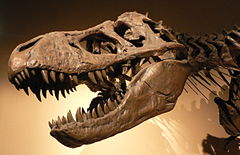
- Dinosaurs did not become extinct due to being generally maladapted or unable to cope with normal climatic change, a view found in many older textbooks. In fact, dinosaurs comprised an extremely adaptive and successful group, whose demise was brought about by an extraordinary event that also extinguished many groups of plants, mammals and marine life. The most commonly cited cause is that of an asteroid impact on the Yucatán Peninsula, triggering the Cretaceous–Paleogene extinction event. Also, not all dinosaurs went extinct. Birds evolved from small feathered theropods in the Jurassic, and while most dinosaur lineages were cut short at the end of the Cretaceous, some birds survived. Consequently, dinosaur descendants are part of the modern fauna.
- Mammals did not evolve from any modern group of reptiles. Soon after the first reptiles appeared, they split into two branches, the sauropsids and the synapsids. The line leading to mammals diverged from the line leading to modern reptilian lines (the sauropsids) about 320 million years ago, in the mid Carboniferous period. Only later (in the late Carboniferous or early Permian) did the modern reptilian groups ( lepidosaurs, turtles and crocodiles) diverge. The mammals themselves, being the only survivors of the synapsid line, are the "cousins" rather than "siblings" of modern reptiles.
Human body and health
- Waking sleepwalkers does not harm them. While it is true that a person may be confused or disoriented for a short time after awakening, this does not cause them further harm. In contrast, sleepwalkers may injure themselves if they trip over objects or lose their balance while sleepwalking. Such injuries are common among sleepwalkers.
- In South Korea, it is commonly and incorrectly believed that sleeping in a closed room with an electric fan running can be fatal. According to the Korean government, "In some cases, a fan turned on too long can cause death from suffocation, hypothermia, or fire from overheating." The Korea Consumer Protection Board issued a consumer safety alert recommending that electric fans be set on timers, direction changed and doors left open. Belief in fan death is common even among knowledgeable medical professionals in Korea. According to Yeon Dong-su, dean of Kwandong University's medical school, "If it is completely sealed, then in the current of an electric fan, the temperature can drop low enough to cause a person to die of hypothermia." Whereas an air conditioner transfers heat from the air and cools it, a fan moves air without change of temperature to increase the evaporation of sweat. Leaving a fan running in an unoccupied room will not cool it; in fact, due to energy losses from the motor and viscous dissipation, a fan will slightly heat a room.
- Eating less than an hour before swimming does not increase the risk of experiencing muscle cramps or drowning. One study shows a correlation between alcohol consumption and drowning, but there is no evidence cited regarding stomach cramps or the consumption of food.
- Drowning is often thought to be a violent struggle, where the victim waves and calls for help. In truth, drowning is often inconspicuous to onlookers. In most cases, raising the arms and vocalising are impossible due to the instinctive drowning response. Waving and yelling (known as "aquatic distress") is a sign of trouble, but not a dependable one: most victims demonstrating the instinctive drowning response do not show prior evidence of distress.
- It is a common misconception that hydrogen peroxide is a disinfectant or antiseptic for treating wounds. While it is an effective cleaning agent, hydrogen peroxide is not an effective agent for reducing bacterial infection of wounds. Furthermore, hydrogen peroxide applied to wounds can impede healing and lead to scarring because it destroys newly formed skin cells.
- The caduceus, a symbol featuring two snakes around a staff, is often mistakenly used as a symbol of medicine instead of the Rod of Asclepius, which features a single snake around a staff. This error was popularised largely because of its adoption in the insignia of the US Army medical corps at the insistence of an officer.
- Human blood in veins is not blue. In fact, blood is always red due to hemoglobin. Deoxygenated blood has a deep red color, and oxygenated blood has a light cherry-red color. The misconception probably arises for two reasons: 1) Veins below the skin appear blue. This is due to a variety of reasons only weakly dependent on the colour of the blood, including light scattering through the skin, and human colour perception. 2) From the way diagrams use colors to show the difference between veins (usually shown in blue) and arteries (usually shown in red).
- Exposure to a vacuum, or experiencing uncontrolled decompression, does not cause the body to explode, or internal fluids to boil. Instead, it would lead to a loss of consciousness once the body has depleted the supply of oxygen in the blood, followed by death from hypoxia within minutes.
Senses
- All different tastes can be detected on all parts of the tongue by taste buds, with slightly increased sensitivities in different locations depending on the person, contrary to the popular belief that specific tastes only correspond to specific mapped sites on the tongue. The original tongue map was based on a mistranslation of a 1901 German thesis by Edwin Boring. In addition, there are not 4 but 5 primary tastes. In addition to bitter, sour, salty, and sweet, humans have taste receptors for umami, which is a savory or meaty taste.
- Humans have more than the commonly cited five senses. Although definitions vary, the actual number ranges from 9 to more than 20. In addition to sight, smell, taste, touch, and hearing, which were the senses identified by Aristotle, humans can sense balance and acceleration ( equilibrioception), pain ( nociception), body and limb position ( proprioception or kinesthetic sense), and relative temperature ( thermoception). Other senses sometimes identified are the sense of time, itching, pressure, hunger, thirst, fullness of the stomach, need to urinate, need to defecate, and blood carbon dioxide levels.
Skin and hair
- Water-induced wrinkles are not caused by the skin absorbing water and swelling. They are caused by the autonomic nervous system, which triggers localized vasoconstriction in response to wet skin, yielding a wrinkled appearance. This may have evolved because it gives ancestral primates a better grip in slippery, wet environments.
- Shaving does not cause terminal hair to grow back thicker or coarser or darker. This belief is due to hair which has never been cut having a tapered end, whereas after cutting there is no taper; the cut hair appears to be thicker, and feels coarser due to the sharper, unworn edges. The shorter hairs being "harder" (less flexible) than longer hairs also contributes to this effect.
- Hair and fingernails do not continue to grow after a person dies. Rather, the skin dries and shrinks away from the bases of hairs and nails, giving the appearance of growth.
- Hair care products cannot actually "repair" split ends and damaged hair. They can prevent damage from occurring in the first place, and they can also smooth down the cuticle in a glue-like fashion so that it appears repaired, and generally make hair appear in better condition.
- The redhead gene is not becoming extinct. In August 2007, many news organizations reported that redheads would become extinct, possibly as early as 2060, due to the gene for red hair being recessive. Although redheads may become more rare (for example, mixed marriages where one parent is from a group without the redhead gene will result in no children, but some grandchildren, with red hair), they will not die out unless everyone who carries the gene dies or fails to reproduce. This misconception has been around since at least 1865, and often resurfaces in American newspapers. (See also Disappearing blonde gene.)
Nutrition, food, and drink
- Eight glasses or two to three litres of water a day are not needed to maintain health. The amount of water needed varies by person (weight), activity level, clothing, and environment (heat and humidity). Water actually need not be drunk in pure form, but can be derived from liquids such as juices, tea, milk, soups, etc., and from foods including fruits and vegetables.
- Sugar does not cause hyperactivity in children. Double-blind trials have shown no difference in behaviour between children given sugar-full or sugar-free diets, even in studies specifically looking at children with attention-deficit/hyperactivity disorder or those considered sensitive to sugar.
- Alcohol does not make one warmer. The reason that alcoholic drinks create the sensation of warmth is that they cause blood vessels to dilate and stimulate nerve endings near the surface of the skin with an influx of warm blood. This can actually result in making the core body temperature lower, as it allows for easier heat exchange with a cold external environment.
- Alcohol does not necessarily kill brain cells. Alcohol can, however, lead indirectly to the death of brain cells in two ways: (1) In chronic, heavy alcohol users whose brains have adapted to the effects of alcohol, abrupt cessation following heavy use can cause excitotoxicity leading to cellular death in multiple areas of the brain. (2) In alcoholics who get most of their daily calories from alcohol, a deficiency of thiamine can produce Korsakoff's syndrome, which is associated with serious brain damage.
- It is untrue that a vegetarian or vegan diet cannot provide enough protein for adequate nutrition. In fact, typical protein intakes of ovo-lacto vegetarians and vegans meet and exceed requirements. However, a strict vegan diet does require supplementation of vitamin B12 for optimal health.
- Swallowed chewing gum does not take seven years to digest. In fact, chewing gum is mostly indigestible, and passes through the digestive system at the same rate as other matter.
Brain
- Mental abilities are not absolutely separated into the left and right cerebral hemispheres of the brain. Some mental functions such as speech and language (e.g. Broca's area, Wernicke's area) tend to activate one hemisphere of the brain more than the other, in some kinds of tasks. If one hemisphere is damaged at an early age, these functions can often be recovered in part or even in full by the other hemisphere (see Neuroplasticity). Other abilities such as motor control, memory, and general reasoning are served equally by the two hemispheres.
- Until recently, medical experts believed that humans were born with all of the brain cells they would ever have. We now know that new neurons can be created in the postnatal brain. Researchers have observed adult neurogenesis in avians, Old World Primates, and humans. Adults of these species retain multipotent (see cell potency) neural stem cells in the subventricular zone of the lateral ventricles and subgranular zone of the dentate gyrus. The newborn neurons generated in these areas migrate to the olfactory bulb and the dentate gyrus, respectively, and are believed to integrate into existing neural circuits. The function and physiological significance of adult-born neurons remains unclear. Some studies have suggested that post-natal neurogenesis also occurs in the neocortex, an idea that is disputed.
- Vaccines do not cause autism or autism spectrum disorders. Although fraudulent research by Andrew Wakefield claimed a connection, repeated attempts to reproduce the results ended in failure, and the research was ultimately shown to have been manipulated.
- People do not use only ten percent of their brains. While it is true that a small minority of neurons in the brain are actively firing at any one time, the inactive neurons are important too. This misconception has been commonplace in American culture at least as far back as the start of the 20th century, and was attributed to William James, who apparently used the expression metaphorically.
Disease
- Drinking milk or consuming other dairy products does not increase mucus production. As a result, they do not need to be avoided by those suffering from flu or cold congestion.
- Humans cannot catch warts from toads or other animals; the bumps on a toad are not warts. Warts on human skin are caused by viruses that are unique to humans ( human papillomavirus).
- Neither cracking one's knuckles, nor exercising while in good health, cause osteoarthritis.
- Eating nuts, popcorn, or seeds does not increase the risk of diverticulitis. These foods may actually have a protective effect.
- The Trendelenburg position (lying on the back with the feet elevated) for treating hypotension or shock is not supported by evidence and may in fact be harmful.
- Stress plays a relatively minor role in hypertension contrary to common belief. Specific relaxation therapies are not supported by the evidence. Acute stress has been shown to temporarily increase blood pressure levels. Evidence from observational studies has shown that chronic stress can be associated with a sustained rise in high blood pressure. From the medical perspective, stress plays a small part in hypertension, whereas a recurring theme in studies of the attitudes of lay people was that stress was by far the most important cause.
- In those with the common cold the colour of the sputum or nasal secretion may vary from clear to yellow to green and does not indicate the class of agent causing the infection.
Materials science
- Glass does not flow at room temperature as a high- viscosity liquid. Although glass shares some molecular properties found in liquids, glass at room temperature is an " amorphous solid" that only begins to flow above the glass transition temperature, though the exact nature of the glass transition is not considered settled among theorists and scientists. Panes of stained glass windows are often thicker at the bottom than at the top, and this has been cited as an example of the slow flow of glass over centuries. However, this unevenness is due to the window manufacturing processes used at the time. Normally the thick end of glass would be installed at the bottom of the frame, but it is also common to find old windows where the thicker end has been installed to the sides or the top. No such distortion is observed in other glass objects, such as sculptures or optical instruments, that are of similar or even greater age. One researcher estimated in 1998 that for glass to actually "flow" at room temperatures would take many times the age of the earth.
- Most diamonds are not formed from highly compressed coal. More than 99% diamonds ever mined have formed in the conditions of extreme heat and pressure about 90 miles (150 kilometers) below the earth's surface. Coal is formed from prehistoric plants close to earth surface, and is unlikely to migrate below 2 miles (3.2 kilometers) through common geological processes. Most diamonds that have been dated are older than the first land plants, and are therefore older than coal. Diamonds can be formed from coal in two unlikely and commercially insignificant processes: in subduction zones, and in meteoroid impacts.
Mathematics
- When an event with equally probable outcomes comes out the same way several times in succession, the other outcome is not more likely next time. For example, if a roulette ball ends up on black many times in a row, and not once on red (as reportedly happened 26 times on August 18, 1913, in the Monte Carlo Casino), the next ball is not more likely to land on red; red is not "due" (nor, for a fair wheel, is red less likely). This misconception is known as the gambler's fallacy; in reality statistical independence holds, and red is just as likely or unlikely on the next spin as always—sometimes expressed as "the system has no memory". If the event is physically determined, and not perfectly random, the repeated outcome may be more likely. For example, a die that has rolled a six ten consecutive times might be loaded or controlled by hidden magnets, and would be more likely to roll another six. The misconception is due to the true fact that, before starting to roll, probability theory predicts that a run of the same colour several times in succession is unlikely, increasingly so the longer the run.
- There is no evidence that the ancient Greeks designed the Parthenon to deliberately match the golden ratio. The Parthenon was completed in 438 BC, more than a century before the first recorded mention of the ratio by Euclid. Similarly, Leonardo da Vinci's Vitruvian Man makes no mention of the golden ratio in its text, although it describes many other proportions.
Physics
- The Big Bang theory does not provide an explanation for the origin of the universe; rather, it explains its early evolution.
- It is not true that air takes the same time to travel above and below an aircraft's wing. This misconception, sometimes called the equal transit-time fallacy, is widespread among textbooks and non-technical reference books, and even appears in pilot training materials. In fact the air moving over the top of an airfoil generating lift is always moving much faster than the equal transit theory would imply, as described in the incorrect and correct explanations of lift force.
- Blowing over a curved piece of paper does not demonstrate Bernoulli's principle. Although a common classroom experiment is often explained this way, it is false to make a connection between the flow on the two sides of the paper using Bernoulli’s equation since the air above and below are different flow fields and Bernoulli's principle only applies within a flow field. The paper rises because the air follows the curve of the paper and a curved streamline will develop pressure differences perpendicular to the airflow. Bernoulli's principle predicts that the decrease in pressure is associated with an increase in speed, i.e. that as the air passes over the paper it speeds up and moves faster than it was moving when it left the demonstrator's mouth. But this is not apparent from the demonstration.
- The Coriolis effect does not determine the direction that water rotates in a bathtub drain or a flushing toilet. The Coriolis effect, while it indeed exists, is induced by the Earth's daily rotation and is far too weak to affect the direction of water in a typical bathtub drain. The effect becomes significant and noticeable only at much larger scales, such as in weather systems or oceanic currents. Other forces dominate the dynamics of water in drains.
- Gyroscopic forces or geometric trail are not required for a rider to balance a bicycle or for it to demonstrate self-stability. Although gyroscopic forces and trail can be contributing factors, it has been demonstrated that neither are required nor sufficient by themselves.
- The idea that lightning never strikes the same place twice is one of the oldest and most well-known superstitions about lightning. There is no reason that lightning would not be able to strike the same place twice; if there is a thunderstorm in a given area, then objects and places which are more prominent or conductive (and therefore minimize distance) are more likely to be struck. For instance, lightning strikes the Empire State Building in New York City about 100 times per year.
- A penny dropped from the Empire State Building will not kill a person or crack the sidewalk. The terminal velocity of a falling penny is about 30–50 miles per hour, and the penny will not exceed that speed regardless of the height from which it is dropped. At that speed, its energy is not enough to penetrate a human skull or crack concrete, as demonstrated on an episode of MythBusters. As MythBusters noted, the Empire State Building is a particularly poor setting for this misconception, since its tapered shape would make it impossible to drop anything directly from the top to street level.
- When the ambient temperature is low, it is not true that temporarily decreasing the temperature setting on a building's programmable thermostat (e.g. at night or when it is unoccupied) rather than maintaining a steady temperature will save little or no energy. A common myth is that if the building is allowed to cool, its furnace has to "work harder" to reheat it to a comfortable temperature, counteracting or even exceeding the energy saved while the temperature was allowed to drop. Actually this practice can result in energy savings of five to fifteen percent as the heat lost by a warm structure in a cold environment is proportional to the heat difference between the inside and outside of the structure.
Psychology
- There is no scientific evidence for the existence of “photographic” or eidetic memory (the ability to remember images with so high a precision as to mimic a camera). Many people have claimed to have a photographic memory, but those people have been shown to have good memories as a result of mnemonic devices rather than a natural capacity for detailed memory encoding. There are rare cases of individuals with exceptional memory, but none of them has a memory that mimics a camera. In recent years, a phenomenon labeled hyperthymesia has been studied, where individuals have superior autobiographical memory—in some cases being able to recall every meal they have ever eaten. One example is actress Marilu Henner.
- Schizophrenia is not the same thing as dissociative identity disorder, namely split or multiple personalities. Etymologically, the term "schizophrenia" comes from the Greek roots skhizein (σχίζειν, "to split") and phrēn, phren- (φρήν, φρεν-; "mind") and is a juxtaposition proposed by the Swiss psychiatrist Eugen Bleuler, which may have given rise to this common misconception.
Sports

- Abner Doubleday did not invent baseball. (See Origins of baseball.)
- The black belt in martial arts does not necessarily indicate expert level or mastery. It was introduced for judo in the 1880s to indicate competency of all of the basic techniques of the sport. Promotion beyond black belt varies among different martial arts. In judo and some other Asian martial arts, holders of higher ranks are awarded belts with alternating red and white panels, and the highest ranks with solid red belts.
Religion
Hebrew Bible
- The forbidden fruit mentioned in the Book of Genesis is commonly assumed to be an apple, and is widely depicted as such in Western art. However, the Bible does not identify what type of fruit it is. The original Hebrew texts mention only tree and fruit. Early Latin translations use the word mali, which can be taken to mean both "evil" and "apple". German and French artists commonly depict the fruit as an apple from the 12th century onwards, and John Milton's Areopagitica from 1644 explicitly mentions the fruit as an apple. Jewish scholars suggested that the fruit could have been a grape, a fig, wheat, or etrog.
Buddhism
- The historical Buddha was not obese. The "chubby Buddha" or "laughing Buddha" is a tenth-century Chinese folk hero by the name of Budai. In Chinese Buddhist culture, Budai came to be revered as an incarnation of Maitreya, the Bodhisattva who will become a Buddha to restore Buddhism after the teachings of the historical Buddha, Siddhārtha Gautama, have passed away.
- The Buddha is not a god. In early Buddhism, Siddhārtha Gautama possessed no salvific properties and strongly encouraged "self-reliance, self discipline and individual striving." However, in later developments of Mahāyāna Buddhism, notably in the Pure Land (Jìngtǔ) school of Chinese Buddhism, the Amitābha Buddha was thought to be a savior. Through faith in the Amitābha Buddha, one could be reborn in the western Pure Land. Although in Pure Land Buddhism the Buddha is considered a savior, he is still not considered a god in the common understanding of the term.
Christianity
- There is no evidence that Jesus was born on December 25. The Bible never claims a date of December 25, but may imply a date closer to September. The fixed date is attributed to Pope Julius the First because in the year 350 CE he declared the twenty-fifth of December the official date of celebration. The date may have initially been chosen to correspond with either the day exactly nine months after Christians believe Jesus to have been conceived, the date of the Roman winter solstice, or one of various ancient winter festivals.
- Nowhere in the Bible does it say exactly three magi came to visit the baby Jesus, nor that they were kings, rode on camels, or that their names were Casper, Melchior and Balthazar. Matthew 2 has traditionally been combined with Isaiah 60:1–3.
-
Arise, shine, for your light has come, and the glory of the Lord has risen upon you. 2For behold, darkness shall cover the earth, and thick darkness the peoples; but the Lord will arise upon you, and his glory will be seen upon you. 3And nations shall come to your light, and kings to the brightness of your rising.
- Three magi are supposed because three gifts are described, and artistic depictions of the nativity after about the year 900 almost always depict three magi. The wise men in the biblical narrative did not visit on the day Jesus was born, but they saw Jesus as a child, in a house as many as two years afterwards ( Matthew 2:11).
- The Immaculate Conception is not synonymous with the virgin birth of Jesus, nor is it a supposed belief in the virgin birth of Mary, his mother. It is the Roman Catholic belief that Mary, unlike all other humans, was not in a state of original sin from the moment of conception.
- Mary Magdalene was not a prostitute. She is often confused with a different, unnamed woman in the Gospel of Luke (immediately before Mary Magdalene's introduction) who indeed was a prostitute. The misconception stems from a 6th-century homily from Pope Gregory I, who assumed that the seven demons that Jesus cast out of Mary Magdalene corresponded to the still-nascent concept of the seven deadly sins.
- Roman Catholic dogma does not say that the pope is either sinless or always infallible. Catholic dogma since 1870 does state that a dogmatic teaching contained in divine revelation that is promulgated by the pope is free from error, although official invocation of papal infallibility is extremely rare. Otherwise, even when speaking in his official capacity, dogma does not hold that he is free from error.
Islam
- A fatwā is a non-binding legal opinion issued by an Islamic scholar under Islamic law. The popular misconception that the word means a death sentence probably stems from the fatwā issued by Ayatollah Ruhollah Khomeini of Iran in 1989 regarding the author Salman Rushdie, whom he stated had earned a death sentence for blasphemy. This event led to fatwās gaining widespread media attention in the West.
- The word " jihad" does not always mean " holy war"; literally, the word in Arabic means "struggle". While there is such a thing as " jihad bil saif", or jihad "by the sword", many modern Islamic scholars usually say that it implies an effort or struggle of a spiritual kind. Scholar Louay Safi asserts that "misconceptions and misunderstandings regarding the nature of war and peace in Islam are widespread in both the Muslim societies and the West", as much following 9/11 as before.
- The Quran does not promise martyrs 72 virgins in heaven. It does mention virgin companions, houri, to all people—martyr or not—in heaven, but no number is specified. The source for the 72 virgins is a hadith in Sunan al-Tirmidhi by Imam Tirmidhi. Hadiths are sayings and acts of the prophet Mohammed as reported by others and as such not part of the Quran itself. Especially the hadiths that are weakly sourced, such as this one, must not necessarily be believed by a Muslim. Furthermore, the correct translation of this hadith is a matter of debate.
Literature
- Frankenstein was not the name of the monster in the novel Frankenstein; or, The Modern Prometheus by Mary Shelley; rather it was the surname of the monster's creator, Victor Frankenstein. The monster is instead called Frankenstein's monster. Additionally, Frankenstein was a medical student in the novel, not a doctor as frequently portrayed.
Music
- " Edelweiss" is not the national anthem of Austria, but is in fact an original composition created for the musical The Sound of Music. The actual Austrian national anthem is " Land der Berge, Land am Strome."
- " Twinkle Twinkle Little Star" was not composed by Wolfgang Amadeus Mozart; he only composed variations on the tune, which originated from a French folk song.
Technology
Inventions
- George Washington Carver did not invent peanut butter, though he reputedly discovered three hundred uses for peanuts and hundreds more for soybeans, pecans, and sweet potatoes.
- Thomas Crapper did not invent the flush toilet; flushing toilets were first used in the Indus Valley Civilization, around the 26th century BCE. Crapper, however, did much to increase its popularity and came up with some related inventions, such as the ballcock mechanism used to fill toilet tanks. The derivation of the word 'crap' is unrelated to his name; this is mere coincidence.
- Thomas Edison did not invent the light bulb. He did, however, develop the first practical light bulb in 1880 (employing a carbonized bamboo filament), shortly prior to Joseph Swan, who invented an even more efficient bulb in 1881 (which used a cellulose filament).
- Henry Ford did not invent either the automobile or the assembly line. He did improve the assembly line process substantially, sometimes through his own engineering but more often through sponsoring the work of his employees. Karl Benz (co-founder of Mercedes-Benz) is credited with the invention of the first modern automobile, and the assembly line has existed throughout history.
- Guglielmo Marconi did not invent the radio, but only modernized it for public broadcasting and communication. No single person was responsible for the invention of radio.
- Al Gore never said that he "invented" the Internet, although Gore did say, "During my service in the United States Congress, I took the initiative in creating the Internet." Gore was the original drafter of the High Performance Computing and Communication Act of 1991, which provided significant funding for supercomputing centers, and this in turn led to upgrades of a major part of the already existing, early 1990s Internet backbone, the NSFNet, and development of NCSA Mosaic, the browser that popularized the World Wide Web; however the history of the Internet predates these. Also see Al Gore and information technology.
- James Watt did not invent the steam engine, nor were his ideas on steam engine power inspired by a kettle lid pressured open by steam. Watt developed upon the first commercially successful Newcomen steam engine in the 1760s and 1770s; his new steam engine later gained huge fame.
Computing
- Computers running Macintosh, Linux, or other non-Windows operating systems are not immune to malware such as trojan horses. These operating systems are capable of being infected by malware designed for them; however, due to the market dominance of Microsoft Windows operating systems, most malware is designed to target them rather than other operating systems.
Transportation
- Toilet waste is never intentionally jettisoned from an aircraft. All waste is collected in tanks which are emptied on the ground by toilet waste vehicles. Blue ice is caused by accidental leakage from the waste tank. While passenger trains, on the other hand, have historically flushed onto the tracks; however, modern trains usually have retention tanks on board.

